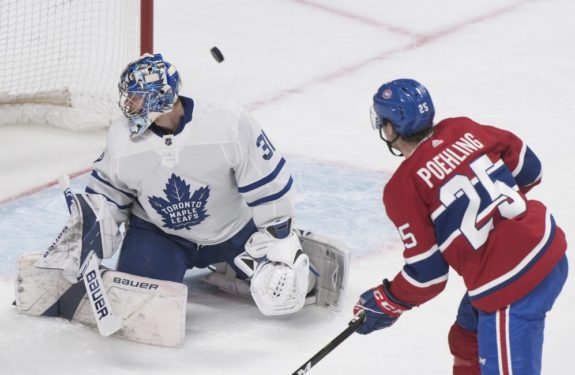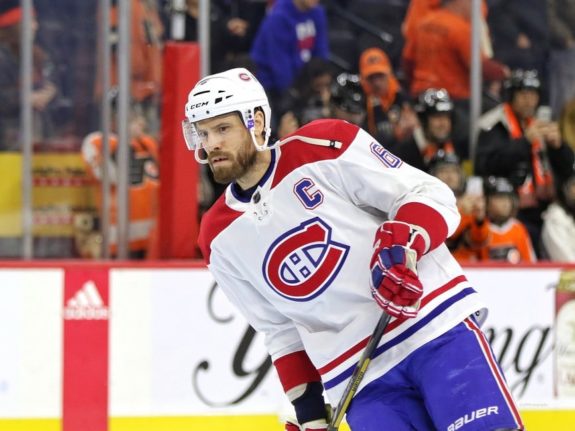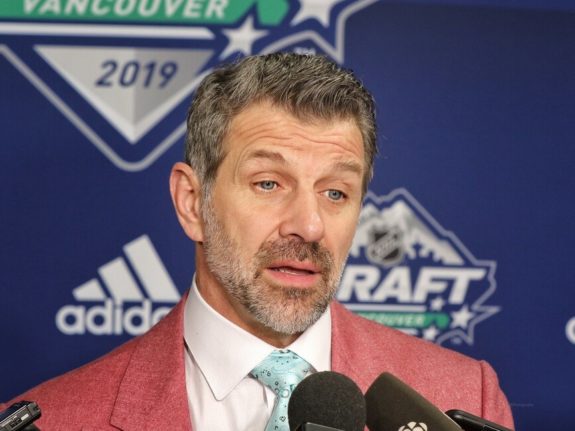The 2021-22 Montreal Canadiens have been historically bad. Just not all bad. It may be hard to watch at times for Habs fans, with the Canadiens solidly in last place, but, if you look hard enough, there’s a light at the end of the tunnel, as these five silver linings show:
5. High Draft Pick
It’s the silver lining that’s the most obvious of all, but that doesn’t make it the least impactful by any stretch. Depending on who the Canadiens take with their high draft pick this coming NHL Entry Draft (coincidentally to be held in Montreal, if everything goes as expected), it may actually turn into the biggest contributing factor to a franchise turnaround.

True, Shane Wright, the projected No. 1 overall pick, may not be a generational talent. But, if the Canadiens do end up lucky enough to get the chance to draft him, that would hypothetically give them the depth down the middle they need, arguably more than the impressive 1,2,3 punch they had had over the last few seasons (prior to this past offseason, when they lost Phillip Danault and Jesperi Kotkaniemi).
It’s also not just Wright, but a litany of prospects who seem to be high-impact NHL players in the making. Each of whom would help the Canadiens kick start their rebuild.
4. More Chances for Habs Prospects
It would be an understatement to say injuries have been a problem for the Canadiens. Not only do they lead the league in the category, but they’re on pace to set a new man-games lost record.
To be fair, injuries are not necessarily a blanket excuse for their season-long swoon. Or at least they shouldn’t be. However, on the plus side, it’s also given opportunities to players in the system, who wouldn’t otherwise have gotten a chance like, Michael Pezzetta (and to a lesser extent Ryan Poehling), call-ups who may potentially stick with the Habs past 2021-22 as a result.

You may look at the cup as being half-empty, in that players like Pezzetta, while valuable, do not have a high ceiling. Still, the situation has definitely revealed a lot about the organization. The Canadiens’ prospect pipeline may be in half-decent condition, but, as the previous era has shown in spades, it’s one thing to draft a lot of players. It’s another to get them NHL-ready. This season has been an eye-opener in that respect.
When you’re undergoing a rebuild, it’s good to have your organizational limitations laid out for everyone to see. Even if it was unintended, it’s an unprecedented level of transparency for this organization. Any organizational weaknesses that have come to light should theoretically be addressed, because doing nothing is not an option. One would think anyway.
3. Carey Price Injury Reveals Holes in Lineup
In much the same vein, it sucks for the Canadiens to have gone without Carey Price up to now. Although, there’s a case to be made that, with them having come this far without him, there’s little point rushing his return, which is still on track for later this season.
True, it’s unlikely Price will be able to turn this ship around by himself at this point. It’s kind of like the Titanic having just hit the iceberg. However, Price could always be counted on to steal a few games at the very least. Without him, the Canadiens have had to rely on backup Jake Allen and depth-goalie Samuel Montembeault. Cayden Primeau, the team’s goalie of the future, has also gotten in a few games, all without anywhere close to the same results you would expect from Price.
It all goes to show how badly this team has come to rely on Price in the past. Maybe, just maybe, his so-so regular seasons in the recent past were in large part due to the team in front of him instead of a reflection on his play. Food for thought, and, with Price getting up there in age (now going on 35), the dinner bell should be ringing ferociously in the minds of general manager Kent Hughes and executive vice president Jeff Gorton.

Sure, one possible conclusion is the Habs absolutely need a franchise goaltender moving forward. Another, conclusion that’s more practical, though? The way this team is constructed, on the foundation of a single player, has more in common with a house of cards than a perennial Stanley Cup contender.
Admittedly, it’s nothing that hasn’t been argued before. However, the consequences are front and center more than ever, even after 2015-16, when Price was limited to just 12 games and the Canadiens wasted a record 9-0 start to the season to miss the playoffs. Something should have been done then. Technically something was, but maybe the wrong thing…
2. Shea Weber Put on LTIR
After the 2015-16 season, Marc Bergevin infamously traded away P.K. Subban for Shea Weber. The controversial trade effectively insulated Price to a greater extent, Bergevin almost doubling down on how the Canadiens were going to live and die with Price. Both outcomes have arguably been proven true over the last half-year.
To Weber’s credit, he played a huge part in the Canadiens’ Stanley Cup Final berth last summer. In effect, the trade worked out in the end, in that both Subban’s Nashville Predators and Weber’s Habs have reached a single Final appearance apiece. However, there’s another reason the trade can and should be considered a wash.

With Weber’s unofficial retirement due to various ailments, the Canadiens are able to put him on long-term injured reserve. It was an oft-underreported drawback of the initial trade, how the Canadiens were taking on a deal that would only expire in 2026, at which point Weber would be 41 years old. Devoting the $7.857,143 in cap space to a player on the decline was always going to be tough, but especially these days with a stagnant ceiling. Now that the Canadiens are off the hook for all intents and purposes, the Subban-Weber trade looks much better.
Related: No Reason for Canadiens to Reacquire P.K. Subban
To lose a player of Weber’s caliber hurts, especially as he’s the captain. However, for the sake of a proper rebuild, it’s for the best. Weber proved to be a warrior for this team, leaving behind a legacy of having led the team to its first Final since 1993. However, with his contract projected to stay off the books and Subban’s expiring this summer, the Canadiens and their fanbase can now move on in more ways than one. At least in principle.
1. Ex-General Manager Marc Bergevin’s Dismissal
One recurring theme on this list has been ex-general manager Marc Bergevin. It’s obviously not a coincidence, even if he’s been off the job for the last few months. It’s maybe a testament to his accomplishments that owner Geoff Molson deemed it necessary to replace him with two men. However, it also shows there was a desperate need for a change.
Bergevin’s Canadiens are obviously not nearly as bad their current record indicates. However, they could never be realistically expected to repeat the run they went on last summer. No, the Canadiens weren’t lucky last playoffs. They earned their spot in the Stanley Cup Final. However, the success was unsustainable due to several factors Bergevin had a direct hand in, namely the dependence on Price, the defense’s overall construction, including a lack of a viable succession plan for a 36-year-old Weber, and the hit the team’s center depth took last offseason.

With Price and Weber as old as they are, a rebuild of some sort was always going to have to come sooner rather than later anyway. In principle, the Canadiens were going to have a hard time making the playoffs as part of the reformed Atlantic Division, but, had they stayed healthy, they could have made a go of it as a bubble team.
The Canadiens’ historically poor season point expedited matters, arguably forcing Molson’s hand to replace Bergevin, when, at one point, he reportedly had an extension on the table. And Bergevin had already gotten two five-year plans (more or less). He could have been in line for a third, realistically staying on if they just barely missed the playoffs. This way, the Canadiens get started sooner than expected on the rebuild, with a much-needed fresh perspective. Fresh start too.
